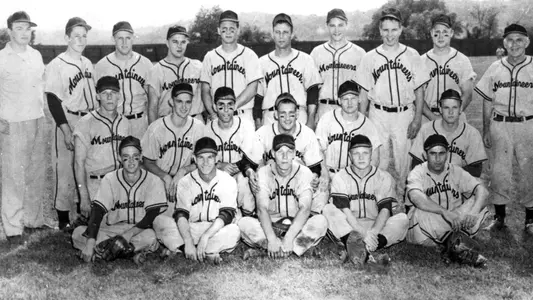
LaNeve Recalls 1955 NCAA Tournament Played in Morgantown
May 27, 2019 10:55 AM | Baseball
MORGANTOWN, W.Va. – The last time West Virginia University played an NCAA Tournament baseball game in Morgantown, Dwight D. Eisenhower was the president.
It's extremely rare for these types of games to be played outside of "Baseball Country" in the Deep South, but it happened here in 1955, and the Mountaineers, the Southern Conference regular-season champions with a 7-2 record, faced Atlantic Coast Conference champ Wake Forest in a best-of-three series at old Hawley Field, located where the WVU Coliseum now sits.
Back then, the NCAA was divided up into eight districts, and West Virginia was part of a five-state area making up District 3.
 WVU won 19-of-23 regular-season games under eighth-year coach Steve Harrick, his team having three All-Southern Conference performers that year in Pennsylvanians Ed Lenart, a first baseman from Trafford, speedy centerfielder Jack Rabbits from Jeannette, and power pitcher Jim Heise, one of college baseball's premier strikeout men with 111 whiffs in 106.2 innings, from Scottsdale.
WVU won 19-of-23 regular-season games under eighth-year coach Steve Harrick, his team having three All-Southern Conference performers that year in Pennsylvanians Ed Lenart, a first baseman from Trafford, speedy centerfielder Jack Rabbits from Jeannette, and power pitcher Jim Heise, one of college baseball's premier strikeout men with 111 whiffs in 106.2 innings, from Scottsdale.
Heise briefly got to the majors in 1957, the righthander making eight appearances for the Washington Senators that season.
The rest of Harrick's lineup consisted of second baseman Christy Kaltenecker from Parkersburg, right fielder Charley McKown from Wayne, left fielder Bill Franko from Chestnut Ridge, Pennsylvania, third baseman Rod Shafer and catcher John Baliker from Morgantown, and shortstop Ronnie LaNeve from Newell.
"That was a long time ago, but I remember there being a lot of excitement in Morgantown for that series with Wake Forest," LaNeve, now 85 and living in nearby Shinnston, recalled Sunday evening.
WVU baseball was beginning to benefit from the great success the Mountaineers were enjoying in the mid-1950s in basketball under Fred Schaus and football under Art "Pappy" Lewis. LaNeve came to WVU on a basketball scholarship while Rabbits was a stellar punt returner on the football team.
LaNeve became baseball's starting shortstop when another basketball player, Red Holmes, was unable to play his senior season in 1954.
"Steve Harrick hit me about 50 or 60 ground balls one spring afternoon and he told me I was the starting shortstop when we got finished," LaNeve said.
Grid stars Freddy Wyant and Sam Huff also played some baseball for the Mountaineers, but they opted to sit out the 1955 season to concentrate on their football careers.
Wake Forest that year boasted All-American catcher Linwood Holt and pitcher Lowell 'Lefty" Davis, a three-sport Demon Deacon star in basketball, baseball and track who is a member of Wake Forest's athletic hall of fame.
"They had an excellent baseball team," LaNeve noted.
Heise was matched up against sophomore Jack McGinley in the series opener on Saturday afternoon, a 5-1 Wake Forest victory that was aided by five Mountaineer errors leading to a pair of runs in the first and fifth.
"Back then, the fields were not manicured like they are today," LaNeve said. "You were always picking up rocks and throwing them off the field before each pitch."
Two days later, West Virginia rallied from six runs down in the top of the ninth to claim a thrilling 9-7 victory over Wake and its ace Davis, previously undefeated in eight decisions.
After one out, Rabbits slugged a triple to center field and then scored on Lenart's bad-hop single to second. Pinch-hitting Don Smith grounded out, but consecutive singles by Jim Baliker and Glen Higgins loaded the bases with two outs.
Heise walked to force in Don Firestone, and then pinch-hitting Rod Shafer and Jim Dayoob also drew walks before Rabbits returned to the plate for a second time in the inning to smash a double to left, clearing the bases to give the Mountaineers a 9-7 lead.
"Davis never lost his control like this," Wake Forest coach Taylor Sanford said afterward.
Heise pitched the bottom of the ninth to earn the save for winning pitcher Tommy Cook, who tossed three innings of scoreless relief in place of starter Don O'Haver.
Harrick either played his hunches right or was giving some seldom-used reserves some playing time in the ninth because West Virginia finished the game with a pitcher in right field, an outfielder on second base, substitutes in left and third, and a utility man at shortstop.
The deciding game on Tuesday afternoon was just as thrilling.
The Mountaineers had a 5-4 lead after five innings until the Demon Deacons plated a run in the sixth to tie the game.
Then in the top of the ninth, Luke McKeel's controversial ground-rule double down the first base line drove in John Stokoe for the go-ahead run. McKeel continued running and crossed home plate while McKown was still trying to retrieve the ball stuck underneath the right-field fence, but following a lengthy argument, the umpires ordered McKeel back to second base once Stanford finally relented after filing an official protest.
"I wanted to get the game over," he said afterward.
In the bottom of the ninth, LaNeve recalled a towering blast Rabbits hit to the deepest part of the ballpark that McKeel was able to chase down 390 feet from home plate.
"Hawley Field was 340 down the lines and about 440 to straightaway center, and if he hits it three-feet to the left or three-feet to the right of him we tie it," LaNeve said.
Stokoe retired Lenart and Firestone to end the game.
Wake Forest advanced to play 1954 NCAA Tournament runner-up Rollins in Winter Park, Florida, where the Demon Deacons claimed both games to advance to the College World Series.
Wake defeated Colgate, Colorado State, Western Michigan, Oklahoma A&M and Western Michigan again to win the national title that year.
 Now, 65 years later, West Virginia coach Randy Mazey has the Mountaineers in position to play more postseason baseball in Morgantown this weekend. This time there will be four teams, with the winner advancing to the NCAA Tournament Super Regionals the following weekend.
Now, 65 years later, West Virginia coach Randy Mazey has the Mountaineers in position to play more postseason baseball in Morgantown this weekend. This time there will be four teams, with the winner advancing to the NCAA Tournament Super Regionals the following weekend.
"I just love what Mazey has done with the baseball team," LaNeve marveled. "I think he's an excellent strategist much like Bob Huggins and Mike Carey are in basketball. He knows when to take pitchers out of games, and his moves are usually the right ones."
The retired LaNeve says he follows the baseball team whenever they're on the radio, and he still tries to make it up to Monongalia County Ballpark occasionally for games.
"What a beautiful ballpark," he concluded. "It's just tremendous what they're doing in baseball at WVU right now."
It's extremely rare for these types of games to be played outside of "Baseball Country" in the Deep South, but it happened here in 1955, and the Mountaineers, the Southern Conference regular-season champions with a 7-2 record, faced Atlantic Coast Conference champ Wake Forest in a best-of-three series at old Hawley Field, located where the WVU Coliseum now sits.
Back then, the NCAA was divided up into eight districts, and West Virginia was part of a five-state area making up District 3.
 WVU won 19-of-23 regular-season games under eighth-year coach Steve Harrick, his team having three All-Southern Conference performers that year in Pennsylvanians Ed Lenart, a first baseman from Trafford, speedy centerfielder Jack Rabbits from Jeannette, and power pitcher Jim Heise, one of college baseball's premier strikeout men with 111 whiffs in 106.2 innings, from Scottsdale.
WVU won 19-of-23 regular-season games under eighth-year coach Steve Harrick, his team having three All-Southern Conference performers that year in Pennsylvanians Ed Lenart, a first baseman from Trafford, speedy centerfielder Jack Rabbits from Jeannette, and power pitcher Jim Heise, one of college baseball's premier strikeout men with 111 whiffs in 106.2 innings, from Scottsdale. Heise briefly got to the majors in 1957, the righthander making eight appearances for the Washington Senators that season.
The rest of Harrick's lineup consisted of second baseman Christy Kaltenecker from Parkersburg, right fielder Charley McKown from Wayne, left fielder Bill Franko from Chestnut Ridge, Pennsylvania, third baseman Rod Shafer and catcher John Baliker from Morgantown, and shortstop Ronnie LaNeve from Newell.
"That was a long time ago, but I remember there being a lot of excitement in Morgantown for that series with Wake Forest," LaNeve, now 85 and living in nearby Shinnston, recalled Sunday evening.
WVU baseball was beginning to benefit from the great success the Mountaineers were enjoying in the mid-1950s in basketball under Fred Schaus and football under Art "Pappy" Lewis. LaNeve came to WVU on a basketball scholarship while Rabbits was a stellar punt returner on the football team.
LaNeve became baseball's starting shortstop when another basketball player, Red Holmes, was unable to play his senior season in 1954.
"Steve Harrick hit me about 50 or 60 ground balls one spring afternoon and he told me I was the starting shortstop when we got finished," LaNeve said.
Grid stars Freddy Wyant and Sam Huff also played some baseball for the Mountaineers, but they opted to sit out the 1955 season to concentrate on their football careers.
Wake Forest that year boasted All-American catcher Linwood Holt and pitcher Lowell 'Lefty" Davis, a three-sport Demon Deacon star in basketball, baseball and track who is a member of Wake Forest's athletic hall of fame.
"They had an excellent baseball team," LaNeve noted.
Heise was matched up against sophomore Jack McGinley in the series opener on Saturday afternoon, a 5-1 Wake Forest victory that was aided by five Mountaineer errors leading to a pair of runs in the first and fifth.
"Back then, the fields were not manicured like they are today," LaNeve said. "You were always picking up rocks and throwing them off the field before each pitch."
Two days later, West Virginia rallied from six runs down in the top of the ninth to claim a thrilling 9-7 victory over Wake and its ace Davis, previously undefeated in eight decisions.
After one out, Rabbits slugged a triple to center field and then scored on Lenart's bad-hop single to second. Pinch-hitting Don Smith grounded out, but consecutive singles by Jim Baliker and Glen Higgins loaded the bases with two outs.
Heise walked to force in Don Firestone, and then pinch-hitting Rod Shafer and Jim Dayoob also drew walks before Rabbits returned to the plate for a second time in the inning to smash a double to left, clearing the bases to give the Mountaineers a 9-7 lead.
"Davis never lost his control like this," Wake Forest coach Taylor Sanford said afterward.
Heise pitched the bottom of the ninth to earn the save for winning pitcher Tommy Cook, who tossed three innings of scoreless relief in place of starter Don O'Haver.
Harrick either played his hunches right or was giving some seldom-used reserves some playing time in the ninth because West Virginia finished the game with a pitcher in right field, an outfielder on second base, substitutes in left and third, and a utility man at shortstop.
The deciding game on Tuesday afternoon was just as thrilling.
The Mountaineers had a 5-4 lead after five innings until the Demon Deacons plated a run in the sixth to tie the game.
Then in the top of the ninth, Luke McKeel's controversial ground-rule double down the first base line drove in John Stokoe for the go-ahead run. McKeel continued running and crossed home plate while McKown was still trying to retrieve the ball stuck underneath the right-field fence, but following a lengthy argument, the umpires ordered McKeel back to second base once Stanford finally relented after filing an official protest.
"I wanted to get the game over," he said afterward.
In the bottom of the ninth, LaNeve recalled a towering blast Rabbits hit to the deepest part of the ballpark that McKeel was able to chase down 390 feet from home plate.
"Hawley Field was 340 down the lines and about 440 to straightaway center, and if he hits it three-feet to the left or three-feet to the right of him we tie it," LaNeve said.
Stokoe retired Lenart and Firestone to end the game.
Wake Forest advanced to play 1954 NCAA Tournament runner-up Rollins in Winter Park, Florida, where the Demon Deacons claimed both games to advance to the College World Series.
Wake defeated Colgate, Colorado State, Western Michigan, Oklahoma A&M and Western Michigan again to win the national title that year.
 Now, 65 years later, West Virginia coach Randy Mazey has the Mountaineers in position to play more postseason baseball in Morgantown this weekend. This time there will be four teams, with the winner advancing to the NCAA Tournament Super Regionals the following weekend.
Now, 65 years later, West Virginia coach Randy Mazey has the Mountaineers in position to play more postseason baseball in Morgantown this weekend. This time there will be four teams, with the winner advancing to the NCAA Tournament Super Regionals the following weekend."I just love what Mazey has done with the baseball team," LaNeve marveled. "I think he's an excellent strategist much like Bob Huggins and Mike Carey are in basketball. He knows when to take pitchers out of games, and his moves are usually the right ones."
The retired LaNeve says he follows the baseball team whenever they're on the radio, and he still tries to make it up to Monongalia County Ballpark occasionally for games.
"What a beautiful ballpark," he concluded. "It's just tremendous what they're doing in baseball at WVU right now."
Kentucky TV Highlights (NCAA Clemson Regional Final) | June 1
Monday, June 02
Clemson TV Highlights (NCAA Clemson Regional) | May 31
Saturday, May 31
BSB: Clemson Regional Game 1 Recap (vs. Kentucky)
Saturday, May 31
Kentucky TV Highlights (NCAA Clemson Regional) | May 30
Friday, May 30











